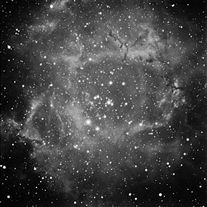TMB130_SBig4K_C28_Ha_NGC2244_PShopFinal_08Feb12-0508Combined.jpg
TMB130_SBig4K_C28_Ha_NGC2244_PShopFinal_08Feb12-0508Combined.jpg
Haven't had much in the way of quality/clear skies recently. So it was a pleasant surprise when Sunday Night opened up the Night Skies. I had been planning imaging sessions for some time and was ready and able to pull off allot of Narrowband Ha Images in one night, including some of the almost totally full Moon that was present.
I run a four Scope Pack, with Mono at Scope1 and Scope3 and OSC at Scope2 and Scope4. Laptop1 controls either of the Mono Cameras and Laptop2 controls either of the OSC Cameras. This does not lend itself to dual Ha imaging on two Mono Cameras. I added two more powered USB hubs into the wiring, which allows me to quickly swap the second Mono Camera with all the additionally connections to Laptop2. After the delay to allow Windows to install the Device Drivers found, everything came up online perfectly.
This image is off the TMB130SS F/7 with Mono Sbig ST4K Camera and through a Baader 35nm Ha Filter. The wider Ha Filter allows me to dual chip, guiding off the second internal chip. While the Filter allows more light to pass through, the larger pixels of the CCD and the slower Focal Ratio requires lots of data to avoid a grainy look. The image is too grainy for my taste, but looks nice when displayed a bit compressed in size.
I have to wait for Rosette [NGC2244] to clear the large Oak trees on the property. That means getting to about 210 degrees in the sky, which is after 12:30AM at this time of year. And Rosette is never high in my Southern Skies, so there's lots of atmosphere to look though. This image is built from 3x 1500-second duration subframes [75 minutes total]. The image is Plate Solved stacked in MaxIM and saved to 16-bit TIFF files and then post processed in PShop.
The skies allowed me to pick up some more subframes on the two different FOV images of Rosette. These were added to the previous 05Feb12 subframes.
I was able to pick up 3x 1800s each image on 08Feb12, for a total of 165 minutes between the two nights.
The TMB130 image second night details: RA 06h 32m 00s, DEC 04d 54m 45s, at 905.0 FL and 1.68"/pixel.
There is no substitute for enough data when building an image.
